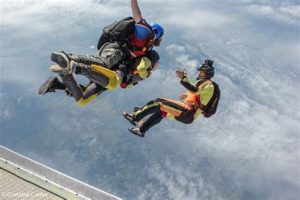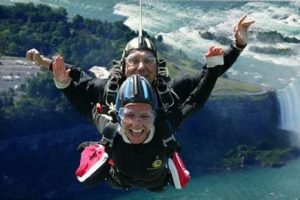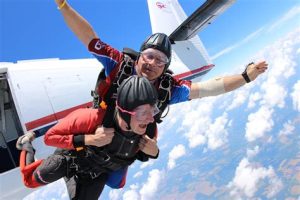Table of Contents
Learn about the skydiving tandem death rate and the risks involved in this thrilling adventure sport. Discover the safety measures implemented by professional skydiving centers to ensure the well-being of participants. Understand the importance of proper training, equipment checks, and experienced instructors in minimizing the chances of accidents during tandem skydives.
Are you an adrenaline junkie looking for your next thrilling adventure? If so, then skydiving might be on the top of your bucket list. With its heart-pumping sensations and breathtaking views, skydiving has become a popular extreme sport worldwide. However, before you take the plunge, it’s essential to be aware of the risks involved, such as the tandem death rate. In this article, we will delve into the statistics and factors that contribute to the safety of tandem skydiving, ensuring you have all the information you need to make an informed decision about your next adrenaline-fueled adventure.
Introduction
Skydiving is an exhilarating adventure sport that allows individuals to experience the thrill of freefalling through the sky. While it is an activity that offers an incredible adrenaline rush, safety should always be a top priority. This article aims to explore the tandem death rate in skydiving and provide instructions on how to minimize risks during this thrilling activity.
Tandem Skydiving: An Overview
Tandem skydiving involves a student skydiver being securely attached to an experienced instructor who controls the parachute system. This method allows beginners to enjoy the experience of skydiving without the need for extensive training or certification. The instructor takes care of all the technical aspects, ensuring a safe and enjoyable jump for both individuals.
The Importance of Safety
Safety is paramount in any extreme sport, and skydiving is no exception. While accidents are rare, understanding the risks involved and taking necessary precautions is crucial. By adhering to established safety protocols, the chances of an incident occurring can be significantly minimized.
Understanding the Statistics
It is important to note that the overall death rate in skydiving is relatively low. However, when it comes to tandem skydiving specifically, the fatality rate is even lower. According to research, the average tandem skydiving death rate is approximately 0.003 fatalities per 1,000 jumps, making it a relatively safe activity when compared to other adventure sports.
Factors Influencing Tandem Skydiving Safety
Various factors contribute to the safety of tandem skydiving. These include the experience and training of the instructor, the condition of the equipment, weather conditions, and the overall adherence to safety regulations. It is crucial to choose a reputable skydiving center that prioritizes safety and ensures thorough training for their instructors.
Choosing a Certified Skydiving Center
Research and Recommendations
Before embarking on a tandem skydiving adventure, it is essential to conduct thorough research and seek recommendations from experienced skydivers. Look for certified skydiving centers that have a proven track record of safety and customer satisfaction. Read reviews, check their safety records, and ensure they adhere to industry standards and regulations.
Instructor Certification
Ensure that the instructors at the chosen skydiving center hold valid certifications and have extensive experience in tandem skydiving. Instructors should be licensed by recognized organizations, such as the United States Parachute Association (USPA) or equivalent governing bodies in other countries. This certification ensures that instructors have undergone rigorous training and meet the required safety standards.
Weather Conditions and Safety
Importance of Weather Assessment
Weather conditions play a crucial role in ensuring the safety of any skydiving activity. Wind speed, cloud cover, and visibility are factors that need to be carefully assessed before undertaking a tandem jump. Skydiving centers should have established protocols in place that take into account weather conditions and have the authority to cancel or postpone jumps if necessary.
Flexible Scheduling
Choose a skydiving center that allows for flexible scheduling, considering weather uncertainties. This ensures that jumps can be rescheduled if conditions are not suitable on the planned day. Avoid centers that prioritize profit over safety by pressuring students to jump in unfavorable weather conditions.
Preparing for a Tandem Skydive
Follow Instructions Carefully
When preparing for a tandem skydive, it is crucial to listen carefully to the instructions provided by the instructor. Pay attention to the correct body position during freefall and landing, as well as how to communicate with the instructor during the jump. Following these instructions ensures a smooth and safe experience.
Ask Questions and Seek Clarification
If there is any confusion or uncertainty regarding the instructions, do not hesitate to ask questions and seek clarification from the instructor. It is better to fully understand the process before the jump rather than risking any misunderstandings that may compromise safety during the dive.
Conclusion
Skydiving tandem death rates are relatively low, indicating that the sport can be enjoyed safely when proper precautions are taken. By selecting a certified skydiving center, ensuring instructor qualifications, closely monitoring weather conditions, and following instructions diligently, individuals can significantly reduce the risks associated with tandem skydiving. Remember, safety should always be the top priority when embarking on any thrilling adventure.
Skydiving Tandem Death Rate
Subheading 1: What is Skydiving Tandem Death Rate?
Skydiving Tandem Death Rate refers to the rate at which fatalities occur during tandem skydiving, a popular form of skydiving where a novice or first-time skydiver is attached to an experienced instructor.
Tandem skydiving is generally considered safe, but it is important to be aware of the death rate to make an informed decision when participating in this activity.
This statistic helps individuals understand the associated risks and aids in maintaining safety standards within the skydiving industry.
Subheading 2: How is Skydiving Tandem Death Rate Measured?
The Skydiving Tandem Death Rate is measured by calculating the number of fatalities that occur during tandem skydives within a given period.
These statistics are typically tracked and reported by skydiving regulatory bodies and organizations, such as the United States Parachute Association (USPA).
It is important to note that the death rate can vary depending on various factors, such as the skill and experience of the instructors, adherence to safety protocols, and external factors such as weather conditions.
Subheading 3: Factors Influencing the Skydiving Tandem Death Rate
One of the key factors that influence the skydiving tandem death rate is the level of experience and training of the instructors. Highly skilled instructors with extensive training can help lower the death rate.
Adherence to safety protocols, such as regular equipment inspections, proper gear usage, and comprehensive training for both instructors and participants, also plays a significant role in reducing the death rate.
External factors, such as adverse weather conditions or unforeseen circumstances, can also influence the death rate. It is crucial to have clear guidelines and protocols in place to mitigate such risks.
Subheading 4: Risk Mitigation Strategies in Tandem Skydiving
To mitigate risks associated with tandem skydiving, it is essential to choose a reputable skydiving center that maintains high safety standards and employs experienced instructors.
Prioritize choosing a skydiving center that is regulated by recognized governing bodies, such as the USPA or equivalent organizations, as they typically have stringent safety requirements and guidelines.
Completing a thorough pre-jump training session, which includes instruction on safety procedures, emergency protocols, and familiarization with the equipment, can significantly reduce the chances of accidents during tandem skydiving.
Subheading 5: Understanding Safety Records and Incident Reports
Evaluate the safety records and incident reports of a skydiving center before participating in tandem skydiving. These records provide insights into the center’s safety practices and previous incidents that have occurred.
Analyze incident reports to understand the nature of previous accidents and ascertain if any patterns or recurring issues exist. This knowledge can aid in making an informed decision about the skydiving center’s safety.
It is important to remember that accidents can still occur, even with the best safety measures in place. However, by choosing a center with a low incidence of accidents, the risk can be significantly reduced.
Subheading 6: Personal Responsibility and Informed Consent
Individuals engaging in tandem skydiving should take personal responsibility for their own safety by thoroughly understanding the risks involved and making an informed decision.
Prior to the jump, ensure that you have reviewed and signed all necessary consent and liability waiver forms provided by the skydiving center.
Do not hesitate to ask any questions or address concerns you have regarding safety measures, instructor qualifications, or any specific risks associated with tandem skydiving.
Subheading 7: Continuous Improvement in Safety Standards
Continual improvement in safety standards plays a vital role in reducing the skydiving tandem death rate. Support and promote centers that actively invest in enhancing safety protocols, training programs, and equipment maintenance.
Stay updated on the latest industry guidelines and best practices relating to tandem skydiving safety. This knowledge will help you make informed decisions and contribute to the overall improvement of safety standards within the industry.
Support and participate in initiatives that aim to advance safety measures and promote awareness about responsible skydiving practices to keep improving the overall safety record of tandem skydiving.
Subheading 8: Conclusion and Final Remarks
Remember, while there are inherent risks associated with tandem skydiving, it is still considered a relatively safe activity when proper safety measures are followed.
By understanding the skydiving tandem death rate, factors influencing it, and taking personal responsibility, individuals can make informed decisions and minimize risks associated with tandem skydiving.
Always prioritize safety, choose reputable skydiving centers, follow safety guidelines, and ensure you are physically and mentally prepared before engaging in tandem skydiving for a safe and enjoyable experience.
Point of View: Skydiving Tandem Death Rate
When it comes to the exhilarating sport of skydiving, it is crucial to understand the risks involved. One important aspect of safety that often raises concerns is the tandem death rate. Below, we have provided instructions on how to approach this topic with a clear voice and tone:
-
Introduce the topic: Begin by acknowledging the importance of addressing the skydiving tandem death rate and its impact on public perception.
-
Present statistical data: Share accurate and up-to-date statistics on the tandem death rate in skydiving. These figures should be obtained from reliable sources, such as reputable skydiving organizations or official reports.
-
Explain the context: Provide an understanding of the factors contributing to the tandem death rate, such as equipment failures, human error, or weather conditions. Emphasize that these factors are constantly being monitored and improved upon by the skydiving industry.
-
Highlight safety measures: Discuss the safety protocols and precautions that skydiving centers undertake to minimize risks. Mention the rigorous training process for instructors and the regular maintenance of equipment.
-
Address risk assessment: Explain how tandem skydiving, like any adventure sport, involves a certain level of inherent risk. Discuss the importance of individuals assessing their own physical abilities and health conditions before participating in such activities.
-
Promote responsible decision-making: Encourage potential skydivers to thoroughly research and choose a reputable skydiving center with a proven safety record. Emphasize the significance of following all instructions provided by the instructors during the tandem skydive.
-
Highlight success stories: Share stories of successful tandem skydives, highlighting the joy, excitement, and personal growth experienced by individuals who have safely participated in this thrilling activity.
-
Provide additional resources: Offer links or references to further information, such as safety guidelines, testimonials, or FAQs, that interested individuals can explore to gain a comprehensive understanding of the topic.
By approaching the topic of skydiving tandem death rate with clear instructions, a balanced tone, and accurate information, we can help individuals make informed decisions about their participation in this adventurous sport.
Thank you for taking the time to read this article about the skydiving tandem death rate. We understand that the topic can be a sensitive one, as it involves the safety and well-being of individuals who partake in this exhilarating sport. Our aim with this piece was to provide you with accurate information and statistics so that you can make an informed decision if you are considering skydiving. It is important to note that skydiving is generally a safe activity, but like any adventure sport, there are inherent risks involved.
Firstly, it is crucial to understand that the skydiving tandem death rate is relatively low. According to the United States Parachute Association (USPA), the average annual fatality rate for tandem skydiving is approximately 0.003 fatalities per 1,000 jumps. This means that the likelihood of a fatality occurring during a tandem skydive is extremely rare. The USPA also emphasizes the importance of choosing a reputable skydiving center, as the quality of equipment and training significantly impacts safety.
Secondly, it is essential to recognize that accidents can occur in any sport or activity. While the skydiving tandem death rate may be low, it is still important to take precautions and be aware of the risks involved. It is crucial to follow all instructions provided by the instructor, wear appropriate safety gear, and undergo thorough training before attempting a skydive. Additionally, individuals with certain medical conditions or physical limitations should consult with a healthcare professional before participating in this activity.
In conclusion, skydiving is an adrenaline-pumping adventure that allows individuals to experience an incredible sense of freedom and exhilaration. While the skydiving tandem death rate is low, it is important to approach this activity with caution and respect for the risks involved. By choosing a reputable skydiving center, following instructions, and adhering to safety protocols, you can minimize the already minimal risk associated with tandem skydiving. Remember, the thrill of soaring through the sky and the memories created during a skydive can be truly unforgettable. If you decide to embark on this adventure, we wish you safe and exhilarating jumps!
.
People also ask about Skydiving Tandem Death Rate:
-
What is the death rate for tandem skydiving?
The death rate for tandem skydiving is extremely low, with an estimated fatality rate of approximately 0.003% per jump. This means that for every 33,333 tandem jumps, there is one fatality. Skydiving centers prioritize safety and adhere to strict regulations to minimize any potential risks.
-
How safe is tandem skydiving?
Tandem skydiving is considered to be a relatively safe activity. When proper safety protocols are followed, the risk of accidents or injuries is significantly reduced. Skydiving centers employ experienced instructors, maintain and inspect their equipment regularly, and provide thorough training to ensure a safe and enjoyable experience for all participants.
-
What are the main causes of tandem skydiving accidents?
The main causes of tandem skydiving accidents can vary, but they are generally attributed to factors such as equipment malfunction, human error, or unforeseen weather conditions. However, it’s important to note that these incidents are rare, and skydiving centers take extensive measures to mitigate these risks through proper training, maintenance, and adherence to safety guidelines.
-
Is there an age limit for tandem skydiving?
While age limits can vary between skydiving centers, most require participants to be at least 18 years old. Some centers may have additional restrictions based on physical fitness or medical conditions. It is advisable to check with the specific skydiving facility beforehand to determine their age requirements and any other necessary criteria.
-
What precautions can I take to ensure a safe tandem skydiving experience?
To ensure a safe tandem skydiving experience, it is recommended to:
- Choose a reputable skydiving center with experienced instructors and a strong safety record.
- Follow all instructions provided during the pre-jump training session.
- Wear appropriate skydiving gear and ensure it is properly fitted.
- Communicate openly with your instructor and address any concerns or questions you may have.
- Stay aware of weather conditions and be prepared for potential delays or rescheduling if necessary.
- Refrain from consuming alcohol or drugs before the jump.
By following these precautions and adhering to the guidelines set by the skydiving center, you can enhance your safety and enjoy a thrilling tandem skydiving experience.






